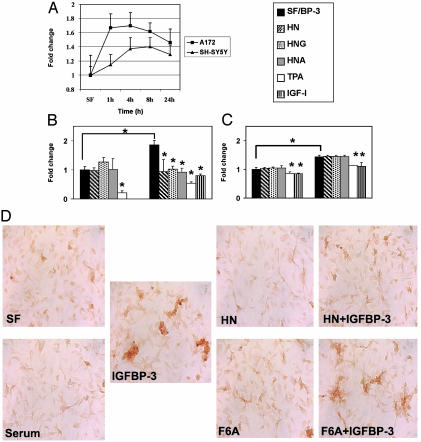Fig. 4.
HN antagonizes IGFBP-3-induced apoptosis. (A) IGFBP-3 induces caspase-3/-7 activation in the A172 glioblastoma and SH-SY5Y neuroblastoma cells. Cells were treated with exogenous (1 μg/ml) rhIGFBP-3 protein in serum-free (SF) media for indicated times (1, 4, 8, and 24 h). Caspase activity for control was measured at 24 h. (B) IGFBP-3-induced caspase activity in A172 cells is blocked by IGF-I, TPA, and HN. A172 cells were treated in SF media with 1 μg/ml IGFBP-3 alone for 6 h or supplemented with HN (100 nM), TPA (25 ng/ml), and IGF-I (100 ng/ml). (C) SH-SY5Y neuroblastoma cells responded to IGFBP-3 by increase in caspase activity at a later time point than A172, and this activation was not blocked by addition of exogenous HN, HNG, or HNA. The values represent fold change compared with the SF (A172 6 h and SH-SY5Y 16 h) control sample. *, P < 0.05 was considered signifi-cant. The results are from three to four independent experiments. (D) HN but not F6A-HN antagonizes IGFBP-3-induced cell death in A172 cells. TUNEL staining of A172 cells treated for 6 h with IGFBP-3 (4 μg/ml) in SF medium, with or without HN or F6A-HN (500 nM). Cells in SF alone or in 10% serum were used as controls.

